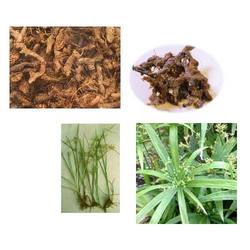NEW DELHI
- GST NO. : 07AAHPG9824B1ZW
View Mobile Number
Cyperus-rotundus (Nagarmotha, Nut grass)

Biological Name:
Cyperus rotundus
Family:
Cyperaceae
Other Names:
Nut grass , Nagar mustaka, Nagarmotha, Nagarmowtha, Korchi-jhar, Moothoo, Mutha, Nagarmothee, Lawala, Koraik-kizhangu, Tungagaddai, Tungamusti, Gandala, Karimuttan, Tangahullu, Koranari-gadde, Bhadramusti.
Habitat:
Cyperus rotundus, a species of sedge native to Africa, southern and central Europe, and southern Asia. It is a plentiful species occurring throughout the plains of India, especially in South India.
Additional Info:
- Katu (pungent), tikta (bitter), kashaya (astringent), laghu (light), ruksha (rough) rasam, seeth veeryam (cold), pitta kapha haram, dipanam, pachnam, in trishna, rakta dosham, jwaram, aruchi, kriminashak.
- Cyperus is an ingredient in popular Ayurvedic formulas such as the herbal honey Chyawanprash, and the women's blood tonic and uterine regulating formula Ashokarishta. It may also be used as a single herb remedy for obesity, digestive problems, and fevers.
Elements Applied:
Tuber or bulbous root is commonly applied element in herbal medicine.
Active Components:
- Cyperus, like other plants, has numerous chemical constituents, many of which may show pharmacological activity, but the main active components appear to be the sesquiterpenes. These are aromatic, spicy tasting molecules. Among the main sesquiterpenes identified in cyperus rhizomes thus far are: α-cyperone, β-selinene, cyperene, cyperotundone, patchoulenone, sugeonol, kobusone, and isokobusone that may scientifically explain the folk- and alternative-medicine uses.
- Cyperus also contains other terpenes, such as the commonly occurring plant component pinene (a monoterpene), and several derivatives of the sesquiterpenes, such as cyperol, isocyperol, and cyperone. These active constituents are found in the volatile oil of cyperus rhizomes, which makes up only about 0.5-1% of the dried rhizome; prolonged cooking of the herb will cause loss of some portion of these constituents. Their main pharmacological actions may be antispasmodic and analgesic effects.
History:
- Cyperus rotundus is thought to have originated in India and then spread from there during the past 2,000 years (it first appeared in a Chinese medicine book around 500 A.D.). The rhizome is used in Ayurvedic medicine, usually called musta, mustak, or mustaka, and is mentioned in the ancient Caraka Samhita (ca. 500 A.D.).
- In the traditional Chinese medicine it is considered the primary Gastro-intestinal regulating herb.
- The plant is mentioned in the ancient Ayurvedic text Charaka Samhita (ca. 100 AD). Modern Ayurvedic medicine uses the plant for treating fevers, digestive system disorders, dysmenorrhea and other maladies.
- Arabs of the Levant traditionally use roasted tubers, while they are still hot, or hot ashes from burned tubers, to treat wounds, bruises, carbuncles.
- Modern alternative medicine recommends using the plant to treat nausea, fever and inflammation; for pain reduction; for muscle relaxation and many other disorders.
Used for:
- Nut grass is a pungent bitter-sweet herb that relieves spasms and pain, acting mainly on the digestive system and uterus. They are used internally in the treatment of digestive problems and menstrual complaints.
- It acts as a carminative, stomachic, demulcent and tonic. It is useful in disorders of the stomach and irritation of the bowels.
- It regulates menstruation, and is effective in conditions such as menstrual irregularities, overdue periods, and abdominal pain during menstruation.
- The plant is rated 8th amongst 250 potential antifertility plants in China. The plant is used in the treatment of cervical cancer.
- Nut grass is recommended for fevers and obesity in Ayurveda.
- Its uses in modern Ayurvedic medicine are primarily for treating fevers and digestive system disorders (diarrhea, vomiting, indigestion, etc.). It is also known as an emenagogue (treats delayed menstruation) and an analgesic useful for dysmenorrhea (painful menstruation). Cyperus is considered a diuretic, but it must be combined with other diuretics to yield a desired result in treating urinary disorders. It is classified as being bitter and astringent, light and dry, cold, pungent (aromatic), and pacifying kapha and pitta.
Safety:
3-6 masha (3-6 gm) per day can be taken safely(Bhavaprakasha Nighantu) . Exercise care. Herbs in Ayurvedic medicine are commonly mixed with other herbal medicines to reduce the toxic effect one of them may produce on the body.
Contact Us
Govind Madhav Herbal Tea
B-29-30, NEW DELHI - 110064, India
Call Us : View Mobile Number
Phone : +91-11-45615006
E-mail : govindmadhavtea@gmail.com

